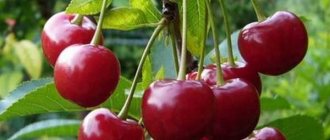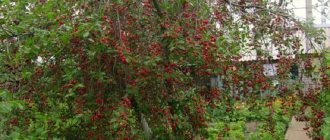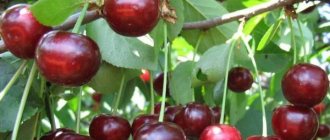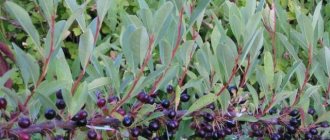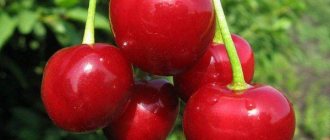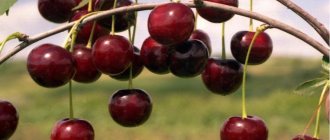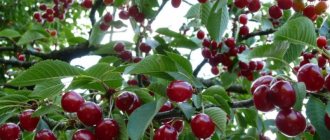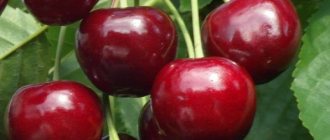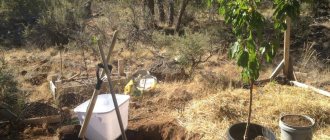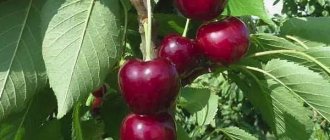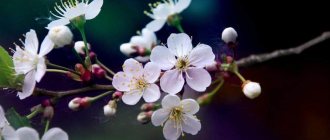Frost-resistant and unpretentious varieties of cherries are popular and take root well in all regions of our country. At the same time, the tree does not require constant attention from the gardener and is able to develop properly and bear fruit abundantly with minimal care.
Mayak is also an unpretentious and hardy variety. A relatively young and not yet widespread variety, it is distinguished by high-quality, tasty, large fruits and resistance to negative environmental factors.
The article will tell you about the characteristics of the bush cherry variety Mayak and the rules for growing it.
Description of the Mayak cherry variety
Mayak is a cherry bred by domestic breeders from Yekaterinburg. The variety was obtained by cross-pollination of annual Michurin cherry seedlings. The originators are S. V. Zhukov and N. I. Gvozduyukova.
It was entered into the state register in 1974. Recommended for cultivation in central Russia, but suitable for cultivation in regions with more severe climates. It is actively grown in Siberia, Belarus, Ukraine and the Baltic states.
Note! Despite the fact that the variety is recommended for cultivation in central Russia, higher yields are recorded in cities with a southern climate.
Main characteristics
The description of the Mayak cherry variety impresses experienced and novice gardeners. This is a hardy plant with high yields and excellent fruit taste.
Characteristics of the Mayak cherry variety:
- Tree. Low, bushy. The height varies between 1.7-2 m. The crown is spreading and of a fairly rare - horizontally elongated - shape. The branches are quite thin, flexible, but at the same time strong. The bark is gray.
- Leaves. The leaf blade is elongated ovoid, the base is wedge-shaped, and the tip is pointed. The edges are covered with jagged edges. The texture of the sheet is quite dense, elastic, glossy. The leaf plate is bent with two sides like a boat. The leaf color is dark green, without a purple tint. The petioles are green with a purple tint, the length reaches 0.7 mm, and the thickness is 0.1 cm. The buds are cone-shaped, reaching a length of 0.4-0.5 cm.
- Bloom. The open flowers are flat, reaching a diameter of 4.2 cm, the petals are arranged freely. The calyxes are goblet-shaped, the sepals have pronounced serrations. The stigma is located at the level or slightly above the anthers. The length of the pistil reaches 1.1 cm, and the length of the stamens is 0.7 cm. The flowers form inflorescences of 3 pieces. Ovaries are formed on annual shoots and bouquet branches. The plant is partially self-pollinating. Flowering lasts from late May to early June (on average a week).
- Fruiting. Lasts from July to September. The fruits are large. Each berry reaches a length of 1.8 cm, a width of 1.7 cm, the thickness of the pulp is 0.7 cm. The weight of each fruit varies between 5-6 g. The fruits are round, slightly compressed on both sides. The skin is dark red, thin, glossy. The pulp and juice are red. The taste is sweet, with a slight sourness. The stone is oval in shape, makes up 6.2% of the fruit's weight (approximately 1/4 g), is brown in color and is easily separated from the pulp. The petiole reaches a length of 4.7 cm and a thickness of 1.2 mm. It is so firmly attached to the berry that it comes off along with the pulp. Mayak cherry fruits contain 1.7% acids and 7.4% sugars. Per 100 g of product there are 2 mg of vitamin C and 101 mg of vitamin P. The berries are prone to cracking.
- Productivity. Tall trees harvest an average of 15 kg of fruit from an adult tree. In the southern regions, the yield increases to a maximum of 25 kg.
- Terms of ripening. Mid-season. Maturation is not friendly. Lasts from July to August.
- Immunity. Average. There is no resistance to fruit rot and coccomycosis. It is especially often affected by aphids and plum sawflies.
- Resistance to negative environmental factors . Frost resistance is high. The plant can tolerate cold temperatures down to -30…-35ºC. It is drought resistant.
- Transportability. Not tall. Cherries spoil quickly. Has a tendency to crack.
Shrub cherry Mayak begins to bear fruit already 3 years after planting. With proper care, it produces crops for more than 30 years.
Note! Although the Mayak cherry is considered partially self-pollinating, it produces high yields only if there are other varieties of this crop on the site. The following varieties of cherries are considered suitable pollinators: Nizhnekamskaya, Truzhenitsa Tatarii, Shakirovskaya.
Advantages and disadvantages
Cherry Mayak has a number of advantages. These include:
- high frost resistance;
- drought resistance;
- high productivity;
- large fruit;
- long fruiting;
- good fruit taste.
The variety also has disadvantages. They are presented in the list:
- susceptibility to certain diseases and pests;
- low transportability;
- spreading crown.
Diseases and pests
Zhivitsa is little susceptible to diseases and pests, like most hybrid varieties.
It is not affected by either coccomycosis or monilial burn, from which cherry plantings have suffered greatly in recent years.
Tsarevna, Shalunya, Ashinskaya and Fairy are also resistant to coccomycosis.
Very rarely, aphids settle on the plant. Even birds (starlings, rooks) damage this hybrid to a lesser extent than other cherry varieties.
High agrotechnical indicators, excellent taste and low maintenance requirements of the hybrid variety Zhivitsa open a wide path for it into farmer and amateur gardens.
The ability to withstand cold allows this hybrid of cherries to be grown in more northern regions
If you are interested in unpretentious varieties of cherries, pay attention to Griot Moscow, Igrushka and Lyubskaya
Watch a video from an experienced gardener about different varieties of cherries, including the Zhivitsa variety.
Planting seedlings
Cherries are planted in open ground in early spring or after leaf fall. It is recommended to buy seedlings in advance - in the fall - and store them outside under a cover of spruce branches. Such planting material turns out to be hardy and hardened.
Selection and preparation of seedlings
In order for the plant to quickly take root and take root well, it is important to choose high-quality planting material. Pay attention to the following parameters:
- Dimensions. The height of the seedling should vary between 60-100 cm. The trunk diameter should be at least 2.5 cm.
- Root system. It must be strong and have many branches. The roots should not be dry, it is important that they are moist when cut. The diameter of the entire root system should vary between 20-30 cm. Seedlings with a closed (in an earthen coma) and open root system are sold. The first option takes root better.
- Branches. The seedling must have several shoots. They should not be dry. To check this, scrape the bark from a small area. There should be green, damp tissue underneath.
Choose annual or biennial seedlings. It is believed that two-year-old cherries take root better.
Seedlings with a closed root system are planted without pre-treatment. The exposed root system is first immersed for 60 minutes in a light pink solution of potassium permanganate, and then for 12 hours in the root formation stimulator “Kornevine”.
Soil preparation and step-by-step planting instructions
In order for the Mayak cherry to bear fruit for a long time and abundantly, it is important to choose a suitable place for it. The tree is planted in a well-lit, not shaded area of the garden. Groundwater should not be located closer than 1.5 m to the surface. It is important that the tree is located on a hill and not in a low place.
Mayak grows best in loamy, sandy and sandy loam soils with neutral acidity. If the values are above 6 pH, add dry lime.
Preparing the soil for planting seedlings begins 3-4 weeks in advance. The soil is dug up to a depth of 0.5 m and cleared of weeds and plant debris. The soil is watered with a hot solution of copper sulfate.
Note! Cherries should not be planted in the place of the old orchard for 5 years after the orchard is uprooted.
The holes for planting steppe (bush) cherries are placed at a distance of 2-3 m from each other, they should have a depth of 60 cm and a diameter of 60-80 cm. The soil removed from the hole is mixed with 5 kg of humus. 1 kg of ash, 30 g of potassium nitrate and 40 g of superphosphate.
Planting technology:
- A 5 cm layer of drainage (shell stone, expanded clay, crushed stone) is poured into the bottom of the hole. A mound is formed from part of the nutrient soil mixture at the bottom of the hole. It should be in the center.
- The tree is placed on an earthen mound. Its roots are evenly distributed around the elevation.
- The hole is filled with the remaining fertile soil. This is done in layers, compacting each layer to expel the air lines.
- The tree is watered generously with 3 buckets of warm water. If the soil settles, add more soil.
- A hole with sides, 50-60 cm in diameter, is formed around the cherry. Mulch (hay, straw, bark, sawdust, peat, humus) is poured into the resulting circle.
Note! Cherries can be planted next to other fruit and berry trees. The exceptions are currants and gooseberries - these shrubs increase the risk of plant infection by infections and pests.
Features of cultivation
Cherry Mayak is a rather unpretentious fruit tree. The survival rate and growth of seedlings will be ideal if a number of conditions are met:
- Landing place. Cherry loves warmth and sufficient lighting, so it should be planted in places not shaded by other trees. At first, you need to cover it from gusts of wind to avoid harming fragile seedlings.
- The soil. The best option for Mayak cherries is fertile, light, well-drained loamy (sandy loam) soil with a neutral reaction. This cherry variety is not a fan of excess moisture, so it is better not to plant it in places where water accumulates. The distance between plantings should be at least 2.5-3 m. Taking into account partial self-pollination, seedlings should be placed next to other varieties of cherries or fruit trees.
- Boarding time. The preferred time for planting cherries is the first days of April, so that the seedlings have time to adapt and take root before the onset of frost. Gardeners in Siberia are recommended to plant them in early spring before the buds open, so that the bushes have time to strengthen and take root during the growing season and survive the winter safely. It is better to start preparatory procedures in the fall, saturating the soil with wood ash (500 mg per 1 sq. m), and after 2-3 weeks, dig up the soil and feed it with fertilizers.
Cherry lighthouse tree
In order for young seedlings to quickly strengthen and begin to grow, it is necessary to ensure timely watering, fertilizing, pruning of dry and rotten branches, and treatment with pesticides.
Watering
It is not recommended to produce too often, because the Mayak variety is well adapted to drought. In the dry season, it is enough to water 1-2 times a month under each tree with up to 20 liters of water. The main thing is not to overdo it to avoid infection of seedlings with root rot. In autumn, it is better to avoid watering altogether.
It is imperative to ensure access of oxygen to the roots, for which, before watering, loosen the soil and mulch, covering the crowns of the sections around the circumference with old sawdust, leaves, husks, straw, and compost.
Feeding
The best compost for cherries is humus and ash. Young trees can be fed with nitrogen fertilizers with the first fertilizing applied in early spring, the second in the form of a potassium-phosphorus mixture - in the fall as the plantings grow
It is important to loosen the soil around the circumference of the seedlings before adding fertilizer. Once every 4 years you can use organic matter (straw, eggshells, onion peels, banana or potato peels)
Once every 5 years it is worth feeding the soil with lime.
Cherry Mayak has large berries
Subtleties of further care
Caring for Mayak cherries will not take much time. This unpretentious plant requires a minimum of gardener attention.
However, it is important to follow the basic rules of care:
- Watering. Young cherries are watered 3-4 times per season. If the winter was snowy, then this is not necessary to do at the beginning of spring. The soil is moistened in May, twice in the summer, on the driest days, and once in the fall if there is little precipitation. For irrigation, use warm, settled water. The procedure is carried out in the morning or evening, when the sun is not active. 2-3 buckets of water are poured under each tree.
- Loosening and weeding. The soil is loosened after each watering and heavy rainfall, as well as in preparation for wintering and after thawing of the soil. During the loosening process, weeds are removed - the main cause of infection of fruit and berry trees and shrubs.
- Mulch. Mulch reduces the frequency of loosening, slows down the growth of weeds, and protects roots from diseases, pests and cold weather. In addition, such a layer plays the role of additional fertilizer. Bark, hay, straw, humus or peat are used as mulch.
- Formation. Mayak cherry is prone to thickening and excessive growth of the bush, so sufficient attention will have to be paid to formative pruning. It is carried out in the spring, 3 weeks before the buds swell. When forming, leave from 7 to 12 skeletal branches located at least 15 cm apart from each other. All weak branches that grow inward and create thickening are removed. Annual shoots are not shortened. For ease of maintenance of the Lighthouse, the growth point is limited to 1.5-2 m.
- Sanitary pruning. It is recommended to do sanitary pruning in the fall after leaf fall. Remove diseased and dry branches.
- Feeding. The first fertilizing is applied 3 years after planting. Nitrogen fertilizers are used in early spring and July. After harvesting, potassium and phosphorus preparations are used. Organic matter is added every 3-4 years.
After pruning, treat the cut areas with garden varnish to avoid gum bleeding, which weakens the tree and causes it to become infected.
Disease and pest control
Mayak cherry is most susceptible to coccomycosis and root rot. Coccomycosis is expressed in the appearance of small red spots on the leaves and shoots, which soon spread to the fruits. The affected parts of the plant dry out and fall off. As a result, cherries simply do not survive the winter.
To get rid of the disease, cherries are treated with fungicides. For prevention, spring treatment is carried out with Bordeaux mixture.
Fruit rot only affects berries. Small brown spots appear on the fruits, which increase in size and lead to rotting of the entire pulp.
To cure the disease, pick off all affected berries. After this, treatment is carried out with copper sulfate.
Of the pests, the greatest danger to Mayak cherries is the plum sawfly and cherry aphids. Both pests feed on the sap of leaves and young shoots. To get rid of insects, the tree is treated with insecticides (Iskra) before or after flowering.
To prevent a tree from being infected by pests, all leaves and plant debris are removed from the area in the fall, weeds are removed throughout the year, and sanitary pruning is carried out in the fall. To prevent diseases, the tree is sprayed with copper sulfate every spring before flowering.
External characteristics of dukes
Dukes belong to stone fruit crops and are cherry-cherry hybrids. If we compare dukes with their parents, then the “children”, taking an intermediate place, took all the best from the parent pairs, but still the vast majority of varieties turned out to be self-sterile. Because of the beauty of their abundant but empty flowering, dukes in the country are often used as an excellent ornamental crop.
The self-sterility of a hybrid crop is associated with exposure to weather conditions. Sudden temperature changes, both unexpected frosts and extreme heat, negatively affect the physiological processes in the plant responsible for the formation of pollen and eggs. The number of normally developed duka flowers capable of pollination can decrease to 1%, sometimes sexually mature flowers are not formed at all. With normal development of only 3-5% of flowers, the crop is literally hung with tasty large fruits with delicate pulp of different shades.
Cherry-cherry hybrids in the south and in regions with mild winters form powerful trees with a wide spreading crown. Breeders have obtained varieties of dukas that bear fruit freely in the cold regions of the North and Siberia, but there it is more practical to grow them in a bush-like form.
The hybrids themselves are more similar to cherries in appearance and quality of the fruit. In terms of the density of the leaf blades and their size, the leaves are more reminiscent of cherry leaves. The leaves are long-petiolate, the arrangement on the shoots is alternate. The color is rich green.
The central trunk of dukes and perennial shoots are smooth (cherry-like), the color of the bark is dark brown. Sometimes skeletal shoots are located at an acute angle to the central trunk.
Depending on the region and climatic conditions, flowering can be early or late. For example, in central Russia, dukes bloom in the last ten days of June, in the south - in May. The flowers are white or slightly pink, collected in bouquet-like inflorescences, which are located on annual growths.
Dukes belong to early-bearing crops and, when good pollinators are selected, already in the third year they form the first (test) fruit crop. At the end of flowering, unpollinated flowers fall off. Formed fruits, on the contrary, remain on the branches for a long time and even improve their taste.
Dyukov fruits are extremely tasty. Imagine a large cherry, whose dense, sweetish-herbaceous pulp has become more tender and acquired an ennobling cherry aroma with a pleasant, refreshing aftertaste.
Reviews from gardeners
Most Mayak gardeners are happy with this cherry. This variety is practically devoid of serious drawbacks.
Irina, Zheleznogorsk: “We planted the Mayak cherry tree in the garden 6 years ago. The first harvest was collected already 3 years after planting. During formation, 10 skeletal branches were left. The harvest increases every year. The variety is drought-resistant, so I water it only if there is no rainfall in the summer. I feed it with ammonium nitrate in the spring, and zala solution in the fall. Once every three years I add a solution of manure. Overall, I’m happy with the variety.”
Victor, Belgorod: “I have Mayak cherries growing in my dacha. In the first year, the tree became ill with coccomycosis. I noticed it in time, so I managed to save him. I simply tore off all the affected leaves and treated them with Iskra. Since then, every spring the garden must be sprayed with copper sulfate. Since then, the cherry has not been sick. I harvest about 20 kg of harvest from 1 tree per season. The taste of the fruit is excellent, the berries are large and sweet. Good fresh, frozen and in pies.”
